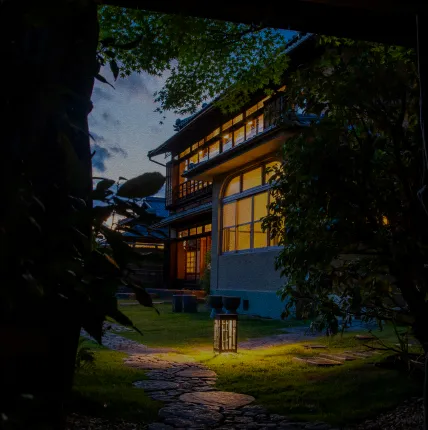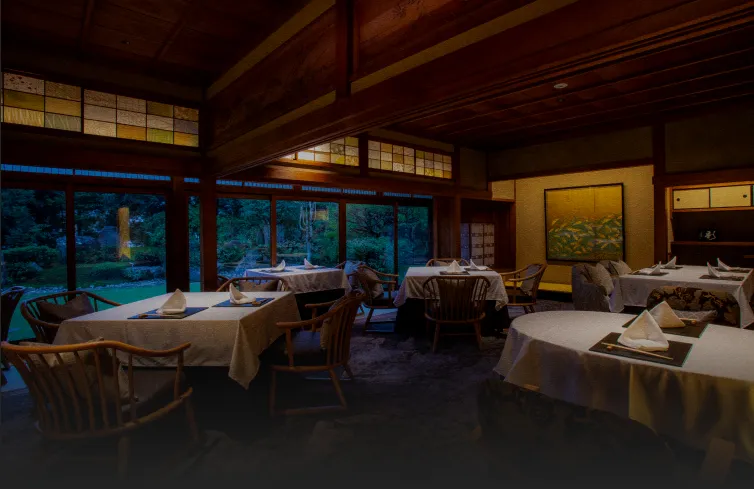
- TOP
- Hotel Guide
Timeless Kyoto –
Hotel Utano Kyoto preserves the refined architectural heritage of the early Showa era,
featuring a shoin-style main building, a sukiya-style annex, a Spanish-inspired Western wing, and an expansive garden.
Originally the residence of prominent industrialist Mitsuzo Owatari, a former executive of Kyoto Electric Light Company,
this estate carries on the legacy of Meiji-era Japanese-Western hybrid mansions.
Discover the unique architectural highlights of this historic property.
建築意匠

Tranquil moments
in a historic setting

The ceiling of the entrance hall features a meticulously crafted goutenjo (coffered ceiling), a traditional architectural technique in which chamfered wooden frames are arranged in a grid pattern. Known for its stately and dignified appearance, this design is often found in shoin (samurai home)-style architecture and temples.
-
The ranma (transom panels) throughout the interior are intricately carved with scenes of Kyoto from the time of construction, including Heian Shrine, Nijo Castle, Togetsukyo Bridge in Arashiyama, Sanjo Bridge, Yasaka Pagoda, and the Higashiyama landscape. The fusuma (sliding doors), adorned with large autumn maple motifs, retain their original cloisonné (shippo-yaki) handles from that era. Additionally, a single solid slab of zelkova wood (keyaki) is used for the tokonoma (alcove) flooring, while the alcove ceiling is crafted from precious Yakusugi cedar.
-
Built as an antechamber to the tea room, this sukiya (teahouse)-style annex retains its traditional architectural features, including an ajiro (woven) ceiling and sabi-kabe walls, both favored in tea house design. Sabi-kabe walls are made by mixing iron powder or iron-infused water from boiled old nails into the plaster, causing rust (sabi) to form over time, creating intricate brown patterns that evolve with age. Due to the way the rusted spots sometimes appear white or black, resembling fireflies, these walls are also known as hotaru-kabe (firefly walls). Observing the ever-changing textures shaped by time is a uniquely Japanese aesthetic experience.

Fusion of Japanese tradition
and Western architecture
Adjacent to the shoin-style main building, the Western wing features gently curved Spanish tiles, stucco-finished walls, and a striking row of arched windows on the second floor. This Art Deco-influenced Spanish-style architecture emerged during Japan’s modernization from the Meiji era to the early Showa period. As a prime example of "wayo heichi-shiki" residences—where Japanese and Western architectural styles coexist—it stands as a symbol of the fusion between Japan’s traditions and Western culture.
-

The windows still feature the original nami (wave)-glass from 1939, preserved and in use since the building’s construction. This hand-blown glass was highly valuable due to its fragility during transport. Each pane has its own unique texture and character, a one-of-a-kind quality that modern mass production simply cannot replicate.
-

This wall is finished using the Otsu-kabe technique, where colored earth is mixed with a small amount of lime and susa (natural fibers), then carefully troweled multiple times to create a smooth, durable surface. The method originated in Otsu, Shiga Prefecture, where high-quality white clay has been sourced for centuries. Though Otsu-kabe requires advanced craftsmanship, the emergence of lime-based coatings has improved workability, leading to artisans skilled in this traditional technique becoming rarer in recent years.

Lounge & Dining
The lobby, which is located at the entrance of the hotel, and the lounge-dining room overlooking the garden, are decorated with light installations created by Eriko Horiki, a washi designer based in Kyoto. Her "Light Walls", "Light Pillars", and shoji paper transom panels unite tradition with innovation in perfect harmony with the historic architecture.
-

PENDANT LIGHTING
Designed with sharp angles, traditionally believed to ward off evil spirits, this pendant light brings a sense of purity to the entrance, creating a serene and welcoming atmosphere for guests.
-

LIGHT WALLS
A tapestry featuring a ring motif symbolizes good fortune expanding through the space, while curved patterns on the storage doors represent the intersection of positive energy. Together, these two elements, inspired by the duality of 'A-un' (om), create a space with a profound cosmic harmony.
-

LIGHT PILLARS
Inspired by the traditional Japanese tatewaku (parallel wavy lines) pattern, which symbolizes the rise of good fortune, this piece is crafted using the delicate sukashi watermarking method to create an airy, refined design.
-

TRANSOM PANELS
A collage of diverse washi papers, handcrafted by artist Horiki throughout her 37-year career, brings authenticity while infusing the space with a sense of playfulness and creativity.





主庭
Eternal beauty of
Japanese gardens
This Japanese garden was designed by Mirei Shigemori, one of Japan’s most renowned landscape architects of the early modern and Showa periods. His original vision, documented at the time of its creation, emphasized key elements such as flat gardens (hiraniwa), artificial hills (tsukiyama), massive stones (kyoseki), boat-shaped stones (funaishi), linear shoreline stones (chokusenjo no hamaishi), and stepping stones (tobiishi). With great respect for its history, the garden has been carefully restored to reflect its former splendor.
At its center lies an expansive lawn, while at the southern edge, a large stone symbolizes Mount Horai atop an artificial hill. Surrounding it, fist-sized stones evoke the flow of water in a karesansui (dry landscape garden), complemented by strategically placed standing stones.


Wabi-sabi in the heart
of the ancient capital
The garden’s stepping stones, patterned stone paths, and large threshold stones are made from Kurama-ishi, a rare stone quarried in northern Kyoto’s Kurama region. Revered for its deep wabi-sabi aesthetic, this stone has long been favored for tea garden landscapes.
年表
-
-
1939 (Showa 14)
-
・Construction completed
Built as the residence of Mitsuzo Owatari, an industrialist who served as an executive of Kyoto Electric Light Co.
- Designed by Ueno Construction Company
- Contractor: Otojiro Tsuda
- Carpenter: Umekichi Okamoto
-
-
-
1940 (Showa 15)
-
・Garden created
Designed and completed by Mirei Shigemori, one of the most emminent landscape architects of the early Showa period.
-
-
-
1954 (Showa 29)
-
・Property acquired by the Kyoto City Transportation Bureau and designated as the Narutaki Dormitory, a recreational facility.
-
-
-
2000 (Heisei 12)
-
・Became a Kyoto City facility and was frequently used as a filming location for drama productions.
-
-
-
2016 (Heisei 28)
-
・Sold to a private owner
-
-
-
2019 (Reiwa 1)
-
・Hotel New Awaji Co., Ltd. acquired land and buildings.
-
-
-
2024 (Reiwa 6)
-
・Recognized as one of the official sites of "The buildings and gardens which make Kyoto attractive"
・Opened as Hotel Utano Kyoto Besho in November
-
HISTORY

施設

Upon arrival, leave luggage to us and unwind in the lounge. Overlooking the garden, this lounge-dining space offers a relaxed atmosphere to enjoy any time during your stay. In the evening and morning, it transforms into a dining area where guests can enjoy carefully prepared meals.
Lounge & Dining
Throughout your stay, this serene space with a view of the garden invites you to relax at your leisure.
During breakfast and dinner, it transforms into a dining area where you can enjoy carefully curated meals.

Lounge
Hours
Dining
Hours

Free drinks, hotel-made sweets, and snacks are available during lounge hours.
Digestif service is also available after dinner.



Gelateria & Boutique
Relish the flavors of Kyoto, Awaji Island, and Setouchi at our Gelateria. In addition to core flavors such as Awaji milk and Kyoto matcha, the hotel patissier offers housemade gelato using seasonal fruits from the Setouchi area. There is also a shop corner featuring curated goods that make perfect souvenirs. The Gelateria is open to the public, and makes a great spot to stop for a rest while exploring this side of Kyoto.

| Hours | 12:00 PM-5:00 PM |
|---|


| Check-in/out | Check-in: 3:00 PM / Check-out: 11:00 AM |
|---|---|
| Internet Connectivity | Wi-fi available throughout the hotel (free) |
| Facilities Information |
【Second floor】 5 guest rooms with hotspring bath 【First floor】 5 guest rooms with hotspring bath/ Reception/Lounge & Dining/ Gelateria & Boutique 【On-site free parking lot】 10 spots/free of charge *Smoking is prohibited in all guest rooms and throughout the entire facility. |
| Total Number of Rooms | 10 |
| Maximum occupancy | 36 |
| Accepted Payment Methods |
Cash, Cashless Payment (PayPay/Alipay/ DoCoMo's "d payment"/Merpay) Credit Card (VISA/JCB/American Express/ Mastercard/Diners Club/Union Pay) |
| Pick-up Information |
We provide a shuttle service to JR San'in Main Line (Sagano Line) Hanazono Station. If you wish to use this service, please make a reservation in advance. Please note that we may not be able to accommodate all requests depending on vehicle availability. Service hours: 2:00 PM–6:00 PM, 9:30 AM–11:30 AM. |
| Address | 14 Oyashiki-cho, Utano, Ukyo-ku, Kyoto City, Kyoto 616-8205 |










